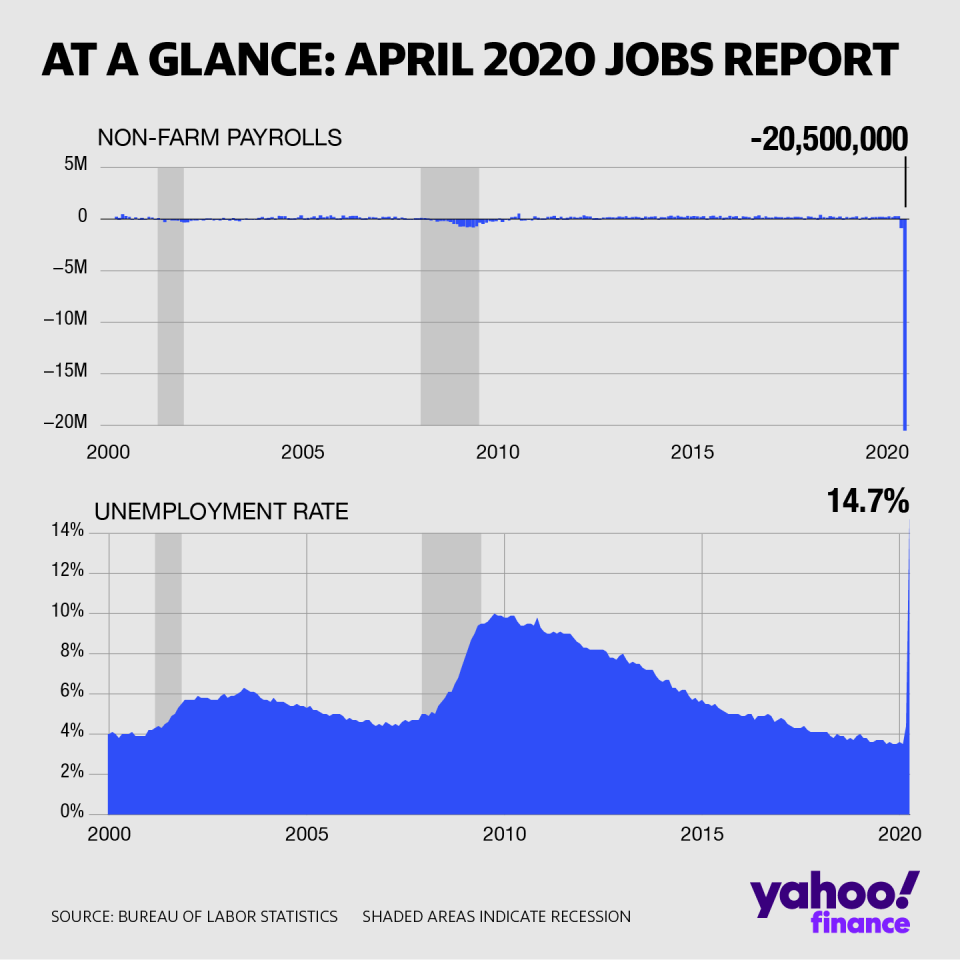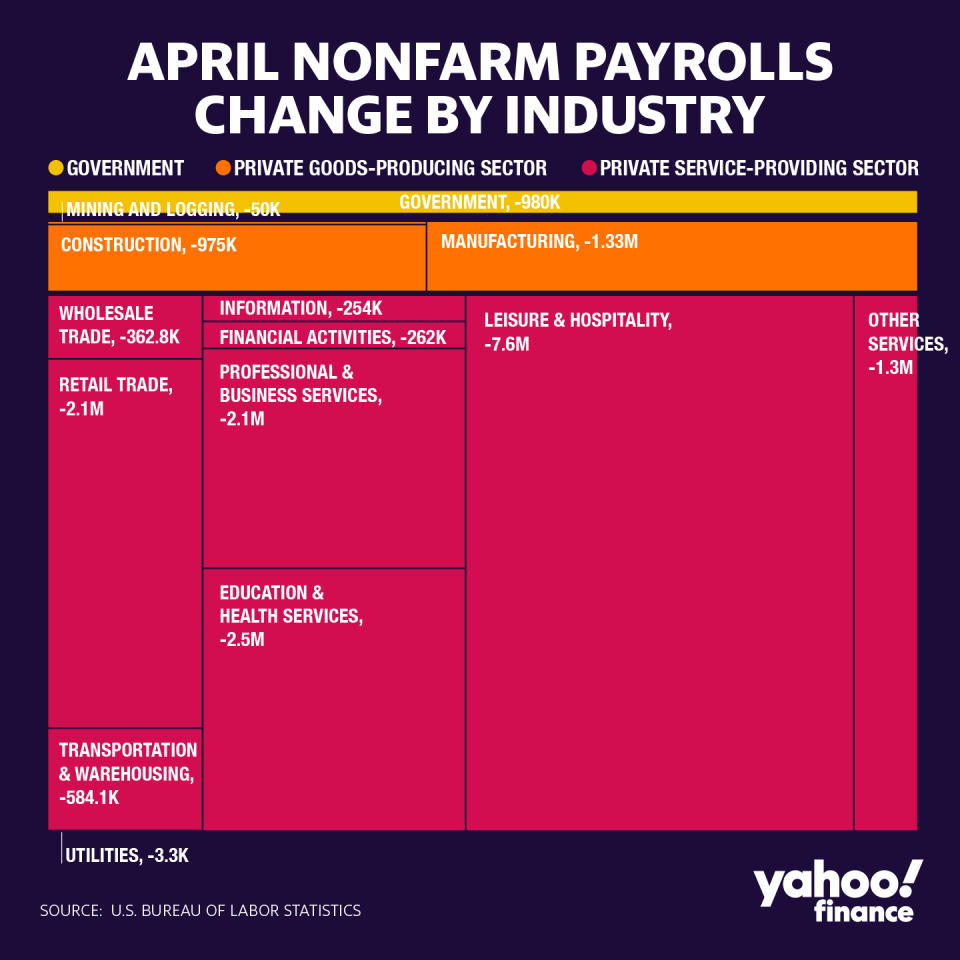April jobs report: U.S. employers cut a record 20.5 million payrolls, unemployment rate jumps to 14.7%
The U.S. economy shed a record 20.5 million payrolls in April and the unemployment rate jumped to 14.7%, as the coronavirus pandemic forced businesses across the country to temporarily shut down and lay off or furlough workers.
Here were the main figures from the U.S. Department of Labor’s report released Friday morning, compared to consensus estimates compiled by Bloomberg:
Change in non-farm payrolls: -20.5 million vs. -22 million expected and -870,000 in March
Unemployment rate: 14.7% vs. 16.0% expected and 4.4% in March
Average hourly earnings month on month: +4.7% vs. +0.4% expected and +0.5% in March
Average hourly earnings year on year: +7.9% vs. +3.3% expected and +3.3% in March
Estimates for April’s change in non-farm payrolls and unemployment rate each spanned a wide range, as economists grappled with gauging the damage as businesses across the country had to cut jobs at a historic rate.
At 20.5 million, the actual decline in payrolls for the month was by far the worst on record, according to government monthly payrolls data spanning back to 1939. The worst fall in payrolls amid the global financial crisis was by 800,000 in March 2009.

April’s decline follows March’s downwardly revised payrolls drop of 870,000, which captured just the very start of the nationwide lockdowns and business closures, since the Labor Department uses the week of the 12th for its reference period.
The unemployment rate surged to 14.7% in April, representing both the largest one-month jump and highest level on record based on monthly Bureau of Labor Statistics (BLS) data spanning back to 1948. The monthly unemployment rate was estimated to have been about 25% at the peak of the Great Depression in 1933.
The jobless rate would have been nearly 5 percentage points higher, if workers were classified differently during the survey data collection, the BLS added in a note.
There was “a large increase in the number of workers who were classified as employed but absent from work,” the BLS said. “As was the case in March, special instructions sent to household survey interviewers called for all employed persons absent from work due to coronavirus-related business closures to be classified as unemployed on temporary layoff. However, it is apparent that not all such workers were classified.”
“If the workers who were recorded as employed but absent from work due to ‘other reasons’ (over and above the number absent for other reasons in a typical April) had been classified as unemployed on temporary layoff, the overall unemployment rate would have been almost 5 percentage points higher than reported (on a not seasonally adjusted basis),” it added.
The BLS’s broader U-6 rate, or underemployment rate, jumped to 22.8% in April from 8.7% the prior month, capturing the percentage of those who became discouraged and stopped looking for a job as well as those working full-time but who wanted a full-time position. The labor force participation rate sank to 60.2%, the lowest since 1973.
Meanwhile, average hourly earnings rose well above consensus expectations both over last month and last year. Heading into the report, some economists had expected wage gains to come in at an even quicker clip than the median estimate suggested, “boosted by compositional effects as a result of the rapid destruction of low wage earners,” Sam Bullard, Wells Fargo Securities senior economist, said in a note Thursday.

Net payroll losses hit every major industry captured in the BLS establishment data in April, as the pandemic-related shutdowns broadened out across the country after March. The service-providing sector was hit hard during the month, shedding more than 17 million jobs versus the 2.4 million lost in the goods-producing sector.
Within the private services sector, leisure and hospitality industries led declines with more than 7.6 million payrolls lost. Professional and businesses services saw payroll losses of 2.13 million, and retail trade endured a drop of 2.1 million. Payrolls for health-care and social assistance industries also dropped by just over 2 million.
For the goods-producing sector, manufacturing payrolls fell by 1.33 million, or less than consensus estimates for a decline of 2.5 million, according to Bloomberg data.
In all, the April report affirmed the cataclysmic labor market conditions already illustrated in other private and government prints. On Wednesday, ADP reported that employers cut private payrolls by a record 20.236 million in April. And initial unemployment claims for the past seven weeks have totaled 33.5 million, with the majority of these coming in April as much of the country went into lockdown.
—
Emily McCormick is a reporter for Yahoo Finance. Follow her on Twitter: @emily_mcck
Read more from Emily:
Disney earnings fall as coronavirus ‘significantly’ impacts parks, but ESPN, Disney+ shine
Warren Buffett: The American economic miracle 'has always prevailed and it will do so again'
What we can learn from the 17 stock market crashes since 1870
Nike 3Q revenue tops expectations as surge in China digital sales helps offset store closures
Find live stock market quotes and the latest business and finance news
For tutorials and information on investing and trading stocks, check out Cashay
Follow Yahoo Finance on Twitter, Facebook, Instagram, Flipboard, LinkedIn, and reddit.


